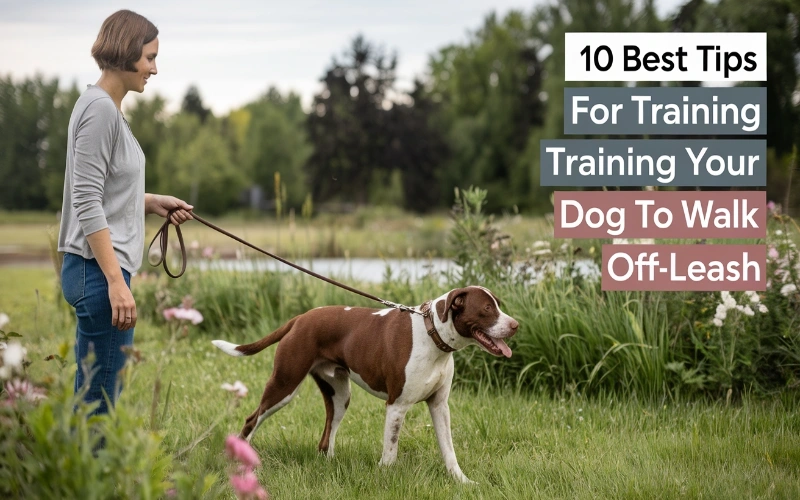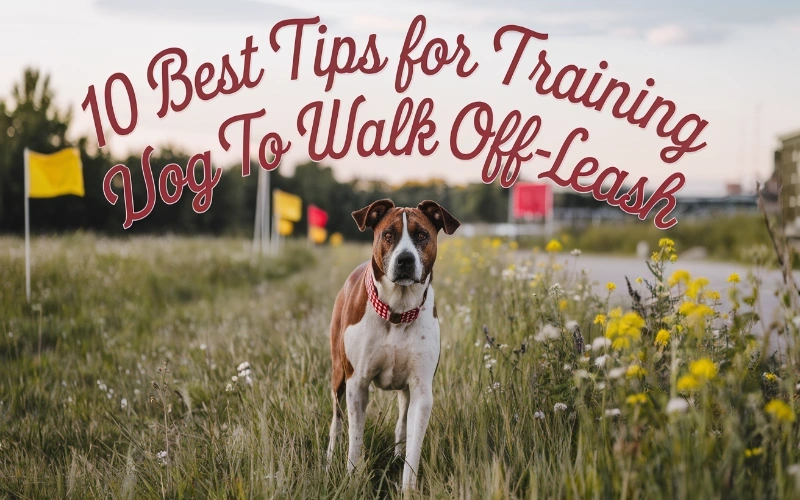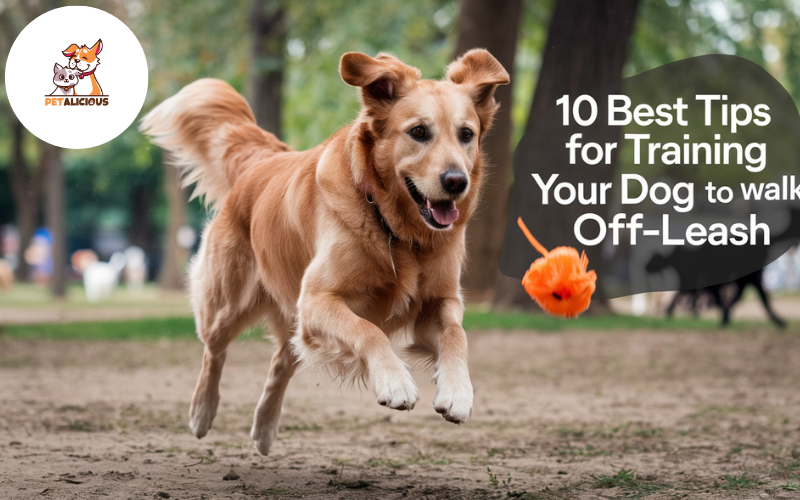10 Best Tips for Training Your Dog to Walk Off-Leash Like a Pro
Before letting your dog roam freely, it is vital to decide if they’re ready for off-leash training. Not all dogs are eligible for it right away. Start by assessing their obedience competencies, don’t forget reliability, and response to distractions. Breeds with a high prey pressure can also require greater training to face up to chasing the natural world. If your dog continually responds to commands like “come,” “lie,” and “leave it”, they’ll be equipped for the next step. However, if they get easily distracted or ignore commands, recognition on reinforcement training before trying the tips for training walk off-leash freedom in open areas. Safety always comes first.
What is off-leash dog training?
Your dog is off-leash whenever you unclip them from their tether. So like whilst you’re walking, trekking, tenting, at a nature park, or some other unfenced location. Off-leash dog training is critical before you’re taking your dog off-leash in any of these conditions. It’s not the same as obedience capabilities, although fundamental obedience commands are the foundation of off-leash education.
Best dog breeds to train off-leash

Every dog’s character is distinctive, even within a particular breed. Dogs that might be bred for hunting, which include Retrievers and Spaniels, are regularly tremendously trainable. (So they’re much more likely to have accurate do not forget.) This makes them excellent selections for off-leash activities. If you plan to take your pup on wilderness hikes, tenting, hunting, therapy, or other off-leash pursuits, these breeds can be off-leash companions:
- Border Collie
- Labrador Retriever
- Golden Retriever
- Australian Shepherd
- German Shorthaired Pointers
On the other hand, puppies with a first-rate-sturdy prey pressure, along with Siberian Huskies, Shiba Inus, Rhodesian Ridgebacks, or Coonhounds, won’t be proper Tips for Training Walk Off Leash activities. Likewise, puppies with competitive inclinations won’t have the proper disposition for going tips for a walk off-leash dog training. It doesn’t imply you mayn’t strive, but depending on your dog’s character, you could have your work cut out for you.
1. Stay Put, Pup! Mastering the “Stay” Command
Teaching your dog to sit or to remain in a single place is vital while you are operating on off-leash obedience training.
Start in less distracting places after which flow to better distracting regions by using consisting of people, other dogs or toys the various distractors.
It’s vital to reward your furry friend every time it stays calm and focused on what you’re coaching it.
Why It Matters: Physical immobilization or bodily restraint may help keep your dog away from being too far off or getting close to a few hostile situations.
2. Essential Training Commands Before Going Off-Leash

Before your dog can enjoy off-leash freedom, they ought to master some key obedience instructions. The maximum vital is the recall command (“Come”), your dog must return to you straight away, no matter the distraction. Other important commands encompass “Stay”, to hold them in the region, and “Leave It”, to prevent them from chasing animals or picking up harmful objects. Training with tremendous reinforcement (treats, praise, or toys) makes studying a laugh and powerful. Start working towards it in a quiet, enclosed place earlier than moving to open spaces. A properly trained dog is a safe and assured off-leash dog.
3. Starting with Long Leash Training
A long leash is the correct tool to transition from leash training to off-leash on foot. It offers your dog a sense of freedom whilst still keeping them under manipulate. Start in a quiet, fenced region and practice commands like “come”, “stay”, and “heel” at increasing distances. Let your dog explore, even as reinforcement, don’t forget training with rewards. Gradually introduce mild distractions, together with different people or dogs, to bolster their attention. The goal is for your dog to pay attention without relying on the leash. Once they reply reliably, you can start working towards open but secure areas.
4. The Power of Positive Reinforcement
Dogs learn high-quality while training is amusing and rewarding. Using positive reinforcement like treats, praise, or preferred toys allows your dog to participate in off-leash training with top experiences. Every time they obey a command, at once reward them immediately so that they understand what they did properly. This technique builds trust and self-belief, making your dog much more likely to pay attention, even in high-distraction regions. Avoid punishment, as it can create fear and make bear in mind training much less powerful. Instead, awareness of consistency and encouragement. A satisfied, properly-rewarded dog is extra eager to live close and follow instructions even if off-leash.
5. Proofing Your Dog’s Recall in High-Distraction Areas

Once your dog listens well in quiet areas, it’s time to prove they don’t forget in greater challenging environments. Start by introducing moderate distractions, like toys or familiar people, in a fenced place. Gradually increase the problem through practising in parks, hiking trails, or open fields wherein there are different puppies, humans, and wildlife. Use high-priced rewards (treats they love most) to maintain their attention on you. If they hesitate, pass returned a step and make stronger training in a controlled setting. The purpose is a 100% dependable consideration, irrespective of the distractions, because safety continually comes first.
6. Common Mistakes in Off-Leash Training (And How to Avoid Them)
Tips for Walk Off Leash your dog training to stroll off-leash takes patience, however, some mistakes can slow progress. One common mistake is shifting too speedily; don’t rush to take off the leash earlier than your dog has a strong consideration in one of a kind settings. Another mistake is not reinforcing commands frequently. Dogs need regular training to stay reliable. Avoid training in high-distraction areas too soon, as this can fail. Lastly, punishing mistakes could make your dog apprehensive instead of responsive. Stay patient, use high-quality reinforcement, and develop step by step. These steps will set your dog up for off-leash success.
7. The Role of GPS Collars and Identification Tags
Even the highly trained dogs can get distracted and wander away. That’s why a GPS collar is a clever safety device for off-leash training. It permits you to tune your dog’s location in real time, giving you peace of mind all through outdoor adventures. ID tags, along with your touch statistics, are also important in case a person finds your dog. Whilethe right training reduces the possibilities of your dog wandering away, surprising matters can occur, like loud noises or surprising distractions. A GPS tracker and ID tag make sure that even in case your dog strays, they can be fast and adequately returned.

8. Legal and Ethical Considerations for Off-Leash Walking
Before letting your dog roam off-leash, it’s essential to realize the local leash legal guidelines in your location. Many parks and public areas require dogs to be leashed for protection motives. Always test for distinct off-leash areas in which your dog can run freely.
Being a accountable proprietor also way considering others some people or puppies might also experience uncomfortable round off-leash pets. Make certain your dog is properly-trained and gained’t technique strangers or wildlife. Respecting policies and being conscious of others guarantees that off-leash strolling remains a fine revel in for everyone.
9. Off-Leash Training for Different Dog Breeds
Not all puppies learn Tips for walk off-leash training at the same pace. Some breeds, like Border Collies and Golden Retrievers, are obedient and eager to thrill, making training less complicated. Others, like Huskies and Beagles, have a robust prey drive, which means that they’ll be more tempted to chase after distractions.
Understanding your dog’s breed traits enables you to alter training methods. High-energy breeds may additionally need greater mental and physical exercise, at the same time as independent puppies require more recall practice. With endurance and consistency, any breed can learn to stroll off-leash, a some simply take a touch greater time.
10. What to Do If Your Dog Runs Away

Even with the first-class off-leash training, dogs can sometimes run off. Stay calm and avoid chasing them, it can cause them to run farther. Instead, use their consider command (“Come”) in a happy, excited tone. If they don’t respond, try a whistle, preferred toy, or an excessive-fee treat to seize their interest.
If your dog continues strolling, check their GPS tracker (in the event that they have one) and begin looking in regions they normally explore. Let others close by know to look out for them. Regularly, do not forget training and an emergency take into account command assist to prevent those situations in the future.
Training My Dog to Walk Off-Leash: A Journey of Trust and Patience
Written by Sarah Lee, Certified Canine Behaviorist, 8+ years of experience.
Training my German Shepherd, Max, to walk off-leash was a journey of patience and trust. Initially, he would bolt at any distraction, making recall unreliable. I started with controlled recall training using high-value treats, then introduced distractions and a long safety line. Over time, his focus improved. The breakthrough came during a hike when a rabbit darted by, and Max hesitated, but chose to return to me. The key was consistency, gradual exposure, and rewarding success. Off-leash training takes time, but with patience and trust, any dog can learn to walk beside you, free yet obedient.
Conclusion
Teaching off-leash dog walking requires time and commitment, along with the correct methods. For your dog to be truly able to experience the freedom of off-leash walking, it is essential to do everything possible to perfect recall commands, use positive reinforcement, and practice in multiple environments before breaking the leash. Don’t forget to train at your dog’s pace, use GPS collars and ID tags to keep them safe, and follow local leash laws.
Ready to start education? Begin with long-leash practice and regularly work your way to off-leash adventures. If you determined these suggestions beneficial, percentage them with different dog proprietors and revel in pressure-loose walks with your furry buddy.
- Top 10 Dog Training Tips for Staying Calm in Public Places
- Why online dog training is Best and more Popular than in-person training
- The 12 Most Common Dog Training Mistakes and Their Solutions
FAQS
Your dog is prepared once they continuously respond to instructions like “come,” “stay,” and “leave it” in special environments. They also have to live targeted, despite distractions, and have no records of strolling away.
You can begin training as early as 3- 4 months with primary instructions; however, complete off-leash schooling must wait until your dog has robust don’t forget capabilities, generally around 6-12 months, depending on the breed.
Stay calm and avoid chasing them. Instead, use their bear in mind command with an excited tone, provide a favourite deal with, or use a whistle recall. A GPS collar can also help song their location fast.
Yes, but some breeds, like Huskies and Beagles, have a strong prey drive and require more training. Obedient breeds, like Labradors and Border Collies, may also learn faster, however, each dog can be trained with persistence.
It relies upon the dog’s personality, breed, and former training. Some puppies are examined in a few weeks, even as others can also take months of steady exercise to master off-leash walking adequately.



